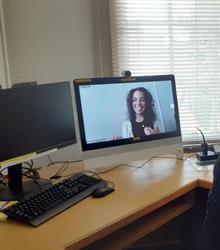Leading-edge technology and tools will permeate almost every element of programming at the facility, which is being purpose-built for mental health and substance use care.
The vision is simple: Use virtual care to break geographical barriers, reaching beyond the walls of the facility to each corner of the province, and make care as seamless, safe and as patient-focused as possible. But how does virtual care work? And what does it look like?
“During the pandemic, the availability of ‘Zoom’ really enabled our virtual work,” said Rebecca Hahn, the executive director of corporate clinical support services at BC Mental Health and Substance Use Services. “But virtual care is more than simple videoconferencing. Zoom for Healthcare is one example — it has enhanced security features, which are important for protecting client privacy. But Zoom for Healthcare is really just the tip of the iceberg when it comes to technology that helps us provider better care. There are so many new technologies that we intend to pilot in the coming years at Red Fish to really advance the use of technology to modernize how we deliver care.”
One of the foundational digital tools at the Red Fish Healing Centre for Mental Health and Addiction is called CST Cerner, which gives care providers access to a client’s medical history, even when they are working remotely. CST stands for clinical systems transformation — and the name is fitting.
 “Imagine someone comes over from St. Paul's Hospital to our facility,” said Dr. Nickie Mathew, the medical director for the Red Fish Healing Centre. “I know exactly what happened there because all the records are already in a shared system. More importantly, all of the patient's records, regardless of where they come from, are in one place, so the patient can have a better understanding of their own journey to recovery.”
“Imagine someone comes over from St. Paul's Hospital to our facility,” said Dr. Nickie Mathew, the medical director for the Red Fish Healing Centre. “I know exactly what happened there because all the records are already in a shared system. More importantly, all of the patient's records, regardless of where they come from, are in one place, so the patient can have a better understanding of their own journey to recovery.”
Many hospitals still rely on paper records, which means patient histories exist only in patchwork pieces, and a care provider might not have access to a patient’s chart when they need it, even if they are working remotely. That means clients need to repeat their histories frequently, which is problematic for a number of reasons.
“On a practical level, it’s not realistic to expect any patient to remember every relevant detail of their care history or to understand what’s important,” said Kathryn Embacher, the senior director of patient care services at the Red Fish Healing Centre. “Things will get missed and mixed up. Equally important is the fact that repeating their story, over and over, can be very challenging for someone who has experienced trauma or had previous challenges with the health care system.”
CST Cerner also allows for electronic medication ordering, which eliminates the need for pharmacists and nurses to decode physician handwriting, reducing the risk of medication errors.
“This improves client safety and saves time for staff,” said Embacher.
Digital signage is another example of technology at the Red Fish Healing Centre. Throughout the centre, digital signage will replace traditional paper-based posters and bulletin boards. Clients will see what activities are planned, which caregivers are working each day, what the weather is like, and even what’s on the daily menu.

“The digital signage helps promote orientation, autonomy and client engagement in their treatment programs,” said Kim Korf-Uzan, the director of e-mental health and special projects at BC Mental Health and Substance Use Services. “It also helps clients feel at home in the facility, giving them access to the information they need to plan their day.”
The digital signage also has an important role in educating and guiding visitors: Signs can promote literacy and reduce stigma by sharing clients’ personal stories and highlighting strengths and passions such as their artwork, music, and hobbies. They can also be used for promoting online resources about concurrent disorders to help people better understand the people we serve.
Several other emerging tools will also enhance care. Given the importance of physical exercise and fitness in healing, clients will have access to electronic devices that will integrate with fitness machines, helping them customize a fitness plan.
Sleep — a vital part of wellness — is also a common challenge for clients at the Red Fish Healing Centre. To help address this, the centre will be outfitted with a state-of-the-art lighting system that mimics natural light and will help clients sleep. In the future, they may also be able to wear monitors that will help assess their sleep patterns.
Clients will also have access to mobile apps such as Breaking Free Online, a substance use relapse prevention program first introduced at the Burnaby Centre for Mental Health and Addiction.
“Breaking Free Online complements existing treatment options,” Korf-Uzan says. “It’s a resource that clients can use outside of group treatment, on their own time. They can advance at their own pace. The platform is also very personalized to the client’s individual challenges, strengths and goals.”
Working with programs like Breaking Free Online, which clients access on a tablet, also helps build digital literacy and is one of the many tools that clients can continue to use when they return to the community.
The centre also includes a multi-purpose room for community events, allowing clients, families, caregivers and educators from across the province to connect together.
 “It’s unusual for a health care facility to be a community hub, but that’s exactly what we’re hoping for with the Red Fish Healing Centre,” said Dr. Vijay Seethapathy, the chief medical officer for BC Mental Health and Substance Use Services. Among other things, we’ll be able to use the multi-purpose room to host the annual B.C. Concurrent Disorders Conference, bringing care providers directly to our facility — both in-person and virtually — to learn from the work we’re doing and from other leaders around the world.”
“It’s unusual for a health care facility to be a community hub, but that’s exactly what we’re hoping for with the Red Fish Healing Centre,” said Dr. Vijay Seethapathy, the chief medical officer for BC Mental Health and Substance Use Services. Among other things, we’ll be able to use the multi-purpose room to host the annual B.C. Concurrent Disorders Conference, bringing care providers directly to our facility — both in-person and virtually — to learn from the work we’re doing and from other leaders around the world.”
Korf-Uzan says that the team is developing a virtual and digital health strategy to guide its direction in the next three to five years.
Possibilities for new advancements include virtual orientation tours of the site, which would give clients and their loved ones a sense of what the facility looks like and who their care providers will be. Technologies such as remote patient monitoring could also help care providers stay in contact with clients and help identify when a client might need help to prevent relapse.
Even virtual reality is a possibility. Clinicians have been looking at the potential of virtual reality to support controlled exposure therapy for clients who have phobias and triggers. By exposing them to a stimulus in a virtual way, clients can learn new and healthy responses to support their recovery.
"We want to be on the leading edge of introducing new and emerging technologies that can transform practice, increase our capacity, and provide a great experience for our clients, families and care providers."
“We’re looking at where we can be really innovative,” said Korf-Uzan. “And I think that’s where the Red Fish Healing Centre has a lot of potential. We want to be on the leading edge of introducing new and emerging technologies that can transform practice, increase our capacity, and provide a great experience for our clients, families and care providers. This will lead to better outcomes and make our system more sustainable.”
This is Part 2 of our two-part series on virtual care at the Red Fish Healing Centre for Mental Health and Addiction, which will open in late 2021. Part 1 explores how virtual technology can extend and enhance care.
